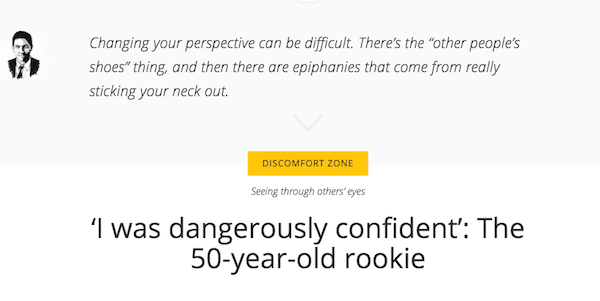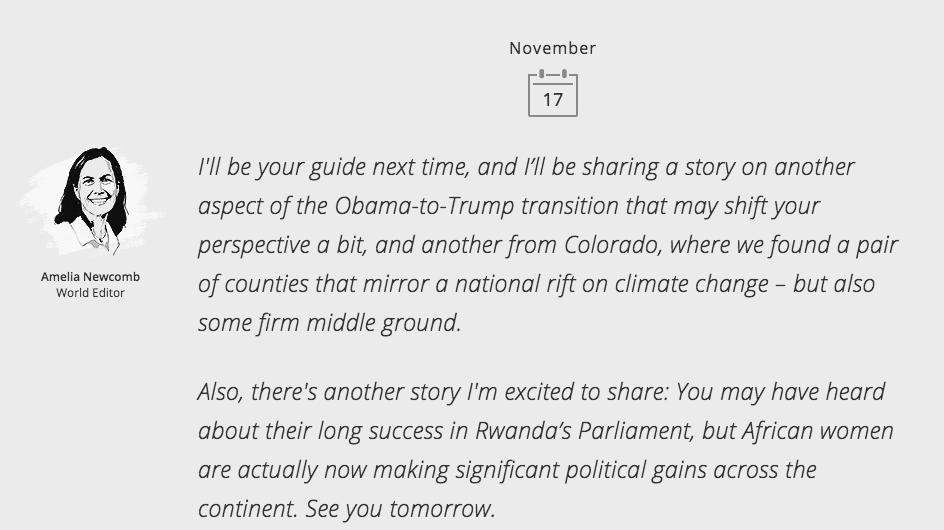
Where do you go, these days, if you want to read news without feeling utterly hopeless about the state of the world? The Christian Science Monitor wants to be that slightly more hopeful place — not by glossing over serious global problems, but by providing counterintuitive insights on issues from the crisis in Aleppo to global warming.
 The Christian Science Monitor is betting big on constructive, non-depressing (but paid-for) newsCan Marketplace reach an audience beyond those who already care about explainer journalism?Ezra Klein hopes Vox can change the fact that “people who are more into the news read the news more”
The Christian Science Monitor is betting big on constructive, non-depressing (but paid-for) newsCan Marketplace reach an audience beyond those who already care about explainer journalism?Ezra Klein hopes Vox can change the fact that “people who are more into the news read the news more”There were a couple of choices. The Monitor could try to pull in a larger web audience with clickbait-y content, “but we felt like we were becoming less ‘us’ the further we went with that.” Instead, the publication decided to “shift to a strategy where we could be more ‘us,’ less like everybody else, and win that way.” The Monitor’s executive team concluded that a daily, digital, subscription product was the way to go — but that, of course, is “something not too many people have succeeded at.”
Ingwerson believes that the Monitor’s digital future is built around shifting perspectives on current events, with a voice that is “calm and fact-based and fundamentally constructive, and assumes that our readers are looking to have a fundamentally constructive approach to the news.” Planning for the new project began long before November 8, but feels especially pressing in the aftermath of the 2016 presidential election.
It’s important, Ingwerson said, not to throw readers into a pit of despair. “We want to look at the news in a way that has fact-based integrity, but creates a legitimate sense of possibility,” he said, “so that, as much as possible, it’s an empowering and not a depressing experience to read the news.”
The Monitor started out by testing its new product with a focus group of eight people, then sent it to thousands on November 16, 17, and 18, along with a survey link. About 1,900 people took the survey.

Respondents “got that we were trying to give them a different perspective on the news, with the ultimate goal that they understand other people better and might ultimately find common ground with them,” Ingwerson said.
Respondents also said they liked the format of the project, which presents each story in capsule form, with an editor intro and a lede that can be expanded to get the full text. “Clarity of purpose” for each story is essential, said Clayton Collins, the Monitor’s weekly edition editor. “That purpose needs to be infused in every intro, every headline, every graphic.”
Such relentless consistency is difficult — both in the context of this beta and, more broadly, in the newsroom. “Our content engine isn’t yet producing this core content as its primary output,” Collins said, and that shift takes buy-in, time, and training — first at the editor level, and editors must then transmit it to their writers.
Over the past couple of years, Monitor management has stressed “the need to hear the voices of others and try to bridge divides” in all its stories, Ingwerson said. That goal is “not alien to our reporters.” Still, it takes a certain amount of practice to write stories that “show a clear shift in perspective — either the story shifts perspective, or it shows someone shifting perspective.”

Monitor readers are “all over the map politically,” according to Ingwerson. “From either side of center, there’s an openness and desire” for a news product like this. “On the extremes, there are people who feel very clear about who the enemy is. Those people are not so interested in seeing or understanding where the other side is coming from. That’s okay; those people may not be that interested in what we’re doing.”
When Ingwerson spoke about the need to understand white working-class Trump voters in the center of the country, I asked him whether a mission to provide more “perspective” placed the burden of understanding on progressive readers while ignoring some of the racism and hatred that marked the election, or insisting on seeing bigotry in a “balanced” way.
Monitor editors had come to him with some of the same concerns. Since the election, the Monitor has run a number of stories “about groups that are very worried about what’s going to happen and the appointments that the Trump administration has made. Those are all legitimate stories. But we haven’t really heard the voices of the, more or less, other half of the electorate that is actually looking forward to what this administration is going to do. I don’t mean the anti-Semitic boobs, the alt-right people excited about what they think it might mean. I mean the rural voters, the Rust Belt voters, who think that this may create jobs, or that some of these trade deals could be negotiated in a better way for U.S. workers…we should hear those voices, too. There should be a balance in the air time those people get.”
False balance, he said, comes when “you’re balancing fact against empty assertion. You need to look at the facts, wherever they lead. If that makes somebody look so bad, so be it. If there are 10 important facts that point one way, and one that might kinda sorta point the other way, then the balance is 10 to 1; it’s not equal time for positive and negative.”
Collins stressed the importance of voice, and how the Monitor’s new product takes the tone of being a guide to the news. “The product we tested uses the editor-moderated approach to story introduction: ‘Here’s what we’re sharing and why.'” Readers need to understand the value of the story immediately and know that what they’ll find in it is different from what they’ve seen in other stories on the topic.
When the Monitor was able to pull this off with its trial product, readers seemed to appreciate it. “We need these perspectives. You are one of the few media sites that I see as unbiased,” one reader wrote in the survey. Another wrote, “I think there’s a need for a courageous news source that is willing to look from multiple perspectives and present those that are counterintuitive and unorthodox.”
Still, while readers appeared to appreciate this type of content, enthusiasm didn’t translate into high traffic, at least not in these tests. The second and third test emails that the Monitor sent out got fewer opens than the first one did. Most of the people who took the survey also didn’t seem to understand that what they were looking at was a “central, replacement product” for the Monitor’s current site, rather than some sort of limited-time “add-on.” Possibly because of that, “we heard more often that it was too much content than too little,” Collins said.
The Monitor wants to lift that engagement rate, of course, but there’s no guarantee that a total revamp of the site, with a paid product at its center, will succeed in doing so. “Our approach is that most news events involve deep levels of nuance, and many portrayals of news are wildly reductive. Part of that is media organizations or social media trying to make the complex super-accessible,” Collins said. “How do we make a news story or news event a starting point for deeper consideration — including considering a range of perspectives that they hadn’t previously weighed, or even thought about?” Such a project doesn’t just require more work from editors and writers, who need to learn to convey stories in a new way; it also requires more work from readers, who may already feel overwhelmed by information.
Still, the Monitor is pressing forward with the hopes that this can become a habit-forming product. While the team hasn’t yet settled on a possible price point (there would always be some content outside a paywall, Collins said), they are aiming for a daily, paid, digital product by April.
“It’s an internal retraining,” said Ingwerson. But it’s “not a sharp turn for us. We’re already a third of the way up the mountain.”